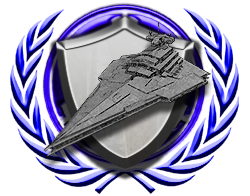Welcome to the Imperial Archives! The main source of information in the Galactic Empire. Be sure to check out the Editing Protocol before making new pages or editing articles. If you need help feel free to contact the Archives manager at archives@swc-empire.com !
Difference between revisions of "Imperial Navy"
Ryan Roche (talk | contribs) m |
m (Added 8IF Flagship) |
||
| Line 82: | Line 82: | ||
* [[6IF]]: IMS Oppressor | * [[6IF]]: IMS Oppressor | ||
* [[7IF]]: IMS Chimera | * [[7IF]]: IMS Chimera | ||
| + | * [[8IF]]: IMS Entor | ||
==Sources== | ==Sources== | ||
Revision as of 10:58, 15 October 2008

| |
| Leadership: | Navy High Command |
| Motto: | "The Protecting Cloak of the Empire's Worlds" |
| Formation: | Unknown circa Year -4 |
| Headquarters: | Kuat |
| Locations: | Galaxy-wide |
| Status: | Active |
The Imperial Navy, also known as the Imperial Starfleet, Imperial Fleet, Imperial Battlefleet, or Imperial Space Service, is the naval branch of the Imperial Military. It fields thousands of warships and fighters, and fuelled by its numerous staff of dedicated officers and loyal pilots, has long been the harbinger of peace and justice throughout the galaxy. The mainstays of its fleets - the Star Destroyer and Super Star Destroyer capital ships and the TIE fighter series of starfighters - became some of the most visible symbols of Imperial rule to the galaxy's civilian populace.
Contents
Introduction
The Navy has grown enormously since the decline of the Old Republic, but its mission has largely stayed the same: to free the system space of member worlds from hazards to profitable commerce, to assure the safety of member worlds from attack from outside forces, and to bolster the planetary governments in times of crisis. The Imperial Navy works closely with the Army performing orbital bombardments, transporting major ground force deployments, and supporting them with space and aerial support.
The Imperial Navy was formed from the Republic Navy around Year -4 during the rise of the Empire. A reorganized command structure oversaw the rapid expansion of the fleet that had begun during the Clone Wars. Some innovations were brought during this time, as the creation of the Grand Admiral rank. The Imperial Navy conducts itself by the Imperial Codex and the regulations written in the Navy Manual.
Changes in Civilian Command Structure
Planetary governments had the right to call upon the Navy of the Old Republic in emergencies. Since the disbanding of the Senate, the Navy is no longer required to respond to requests from planetary governments, including the planetary governors appointed by the Empire. Under new doctrine, individual planets are too insignificant to allow them direct control over an asset as important as the Imperial Navy, even for short periods of time. Civilian orders are now transmitted at the level of the Sector Group, from regional Moffs, Grand Moffs, or the Emperor himself, and always with the knowledge of Naval High Command. Smaller units are to receive their orders only from officers in the proper chain of command. This is a definite change from the Republican Navy, when Senators or other politically powerful beings could directly commandeer naval vessels — sometimes entire squadrons — for missions without having the order come down through the chain of command. This change has greatly boosted the morale of naval personnel. The officers now know that the strategy is being set at a level of authority which is best suited for seeing the whole picture. Naval commanders have the authority and responsibility to execute their orders in the best manner possible, and they know they shall be free from political interference while doing so.
The Navy has responded to its rapid growth by changing its command structure, introducing a bureaucratic-free chain of command, removing the permanent groups within the fleets and optimizing the functionality.
Pilots
Imperial pilots are the mainstay of the Imperial Navy. They are the necessary element in the military branch charged with protecting the space lanes from pirates, smugglers, alien invaders, and Rebels. The top pilots in the galaxy are found in the Imperial Navy. These pilots, following the glorious and time-honored allure established during the Republic, attend the premier academies throughout the Empire. Within these fine institutions, the Empire teaches these men duty and promotes the idea of maintaining order, as opposed to defending against aggression. Each candidate for admission into the rigorous TIE training program must undergo a strenuous screening and testing process. After all, they are being prepared to fly the best starfighters the Empire has to offer.
Fleets
A fleet is designated as a "sector resource," which means it should be available for action anywhere within the sector. A fleet is the smallest unit transferred between sectors. However, current fleets act both in defensive and offensive missions, protecting their home sector but also hunting the enemy everywhere in the galaxy. The Imperial Navy is divided in seven fleets, each one of them composed of an Imperial class Star Destroyer that acts as its flagship, three Victory class Star Destroyers piloted by Fleet Command and senior staff and several capital support ships and fighter squadrons. In the current format, it is estimated that each fleet would work ideally with fifteen members, although the actual number of members that are assigned to each fleet is, of course, classified.
These are the flagships of each fleet:
- 1IF: IMS Tormentor
- 2IF: IMS Inexorable
- 3IF: IMS Impervious
- 4IF: IMS Apollyon
- 5IF: IMS Majestic
- 6IF: IMS Oppressor
- 7IF: IMS Chimera
- 8IF: IMS Entor
Sources
- Star Wars: Imperial Sourcebook
- Imperial Navy on Wookiepedia
- Imperial Navy on Compedia